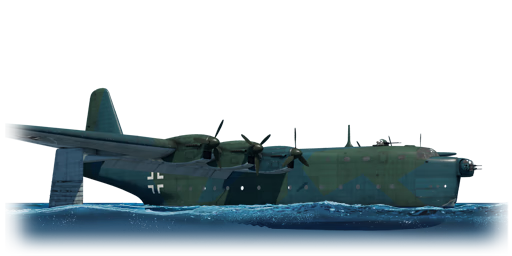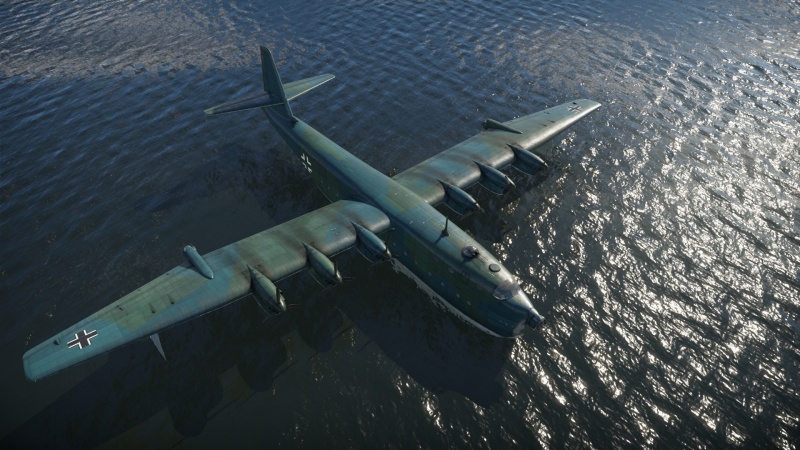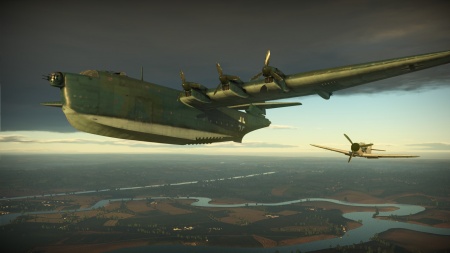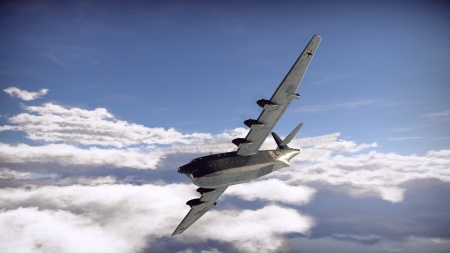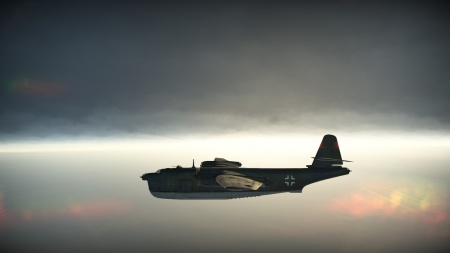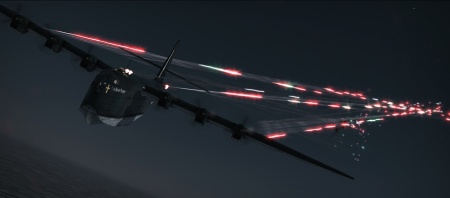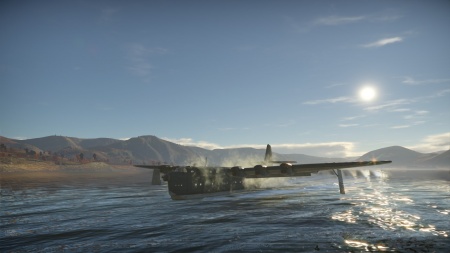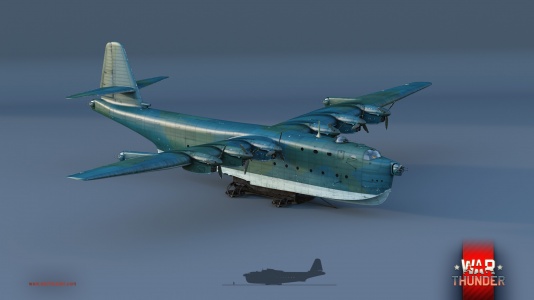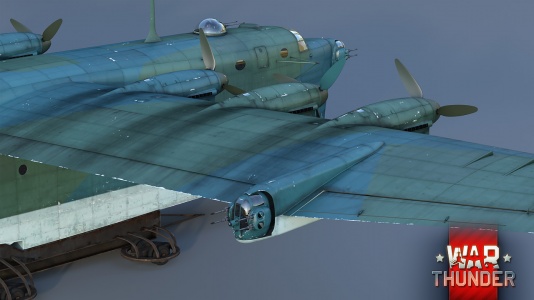Difference between revisions of "BV 238"
(→Media: Added skins) |
|||
| (8 intermediate revisions by 6 users not shown) | |||
| Line 6: | Line 6: | ||
== Description == | == Description == | ||
<!-- ''In the description, the first part should be about the history of and the creation and combat usage of the aircraft, as well as its key features. In the second part, tell the reader about the aircraft in the game. Insert a screenshot of the vehicle, so that if the novice player does not remember the vehicle by name, he will immediately understand what kind of vehicle the article is talking about.'' --> | <!-- ''In the description, the first part should be about the history of and the creation and combat usage of the aircraft, as well as its key features. In the second part, tell the reader about the aircraft in the game. Insert a screenshot of the vehicle, so that if the novice player does not remember the vehicle by name, he will immediately understand what kind of vehicle the article is talking about.'' --> | ||
| − | The '''{{Specs|name}}''' | + | The '''{{Specs|name}}''' was the largest aircraft produced during WWII by the Axis Powers. With a size intended to demonstrate the marvels of German technological superiority, it also served as a show of force. With an equal weight to two B-29A-BN Superfortresses, the aircraft was powered by six DB.603V 12-cylinder radial engines and could reach 424 km/h at 6 km altitude, with a range of over 10,000 km. The aircraft never advanced beyond the experimental stage, since the BV 238 V1 was destroyed by Allies as it sat hidden near the town of Lübeck. |
| − | The | + | The BV 238 was introduced in [[Update 1.63 "Desert Hunters"]]. The BV 238 is a slow though very well-armoured and armed bomber. It is capable of landing in water, which is a rare occurrence for an aircraft of its size. It is very capable thanks to its large bomb payload of 20 x 250 kg bombs which is enough to destroy a base or several ground targets in realistic battles, and is also very well defended, with dorsal turrets consisting of dual MG 151 20 mm autocannons while all other turrets use quad MG 131 HMGs. Thanks to this, an interceptor approaching alone from behind the BV 238 can consider itself destroyed, or at least in grave danger. The best way to deal with the BV 238 is a high speed dive from above, trying to hit the pilots or the engines. A few engines destroyed in the BV 238 are enough to make it lose speed at a constant rate, making it eventually crash. |
| − | |||
| − | |||
| − | |||
| − | |||
| − | |||
| − | |||
| − | |||
== General info == | == General info == | ||
| Line 104: | Line 97: | ||
* 5 mm Steel plate behind pilot. | * 5 mm Steel plate behind pilot. | ||
| − | Though the {{PAGENAME}} almost entirely lacks armour, it is a highly survivable plane. Massive areas of empty space within the fuselage as well as the iconic | + | Though the {{PAGENAME}} almost entirely lacks armour, it is a highly survivable plane. Massive areas of empty space within the fuselage as well as the iconic six engines of this behemoth cause the bomber to be an incredibly tough target to take down. With smart use of Manual Engine Controls to disable engines and manipulate radiators, a BV 238 pilot can nurse even a critically damaged bomber several kilometres home safely. Due to the plane's role as a flying boat, the belly of the bomber is unusually durable, and can easily survive landings on land-based runways in spite of the BV 238's lack of a wheeled landing gear. The wings of this massive aircraft are the weak points, if a cannon bearing aircraft manages to cause one of the wings to snap, there is nothing stopping the {{PAGENAME}} from crashing to the earth. |
In terms of crew members, the {{PAGENAME}} houses an impressive ten crew members, with two crew members in the flight deck and five more each manning various gunner positions around the aircraft, and three more miscellaneous crew. This makes the {{PAGENAME}} very hard to neuter, as the crew members are spaced '''very''' far apart, with one gunner on each wing past the third engine, two near the flight deck, and one in the tail of the aircraft, altogether making it nigh-impossible to prevent return fire from the bomber. | In terms of crew members, the {{PAGENAME}} houses an impressive ten crew members, with two crew members in the flight deck and five more each manning various gunner positions around the aircraft, and three more miscellaneous crew. This makes the {{PAGENAME}} very hard to neuter, as the crew members are spaced '''very''' far apart, with one gunner on each wing past the third engine, two near the flight deck, and one in the tail of the aircraft, altogether making it nigh-impossible to prevent return fire from the bomber. | ||
| Line 176: | Line 169: | ||
* Impressive bomb load (5 tons payload in the form of 20 x 250 kg bombs) | * Impressive bomb load (5 tons payload in the form of 20 x 250 kg bombs) | ||
| − | * Extremely durable airframe, with a large crew | + | * Extremely durable airframe, with a large crew count |
* Excellent defensive armament in most-all directions, eighteen total defensive machine guns and autocannons | * Excellent defensive armament in most-all directions, eighteen total defensive machine guns and autocannons | ||
* Ability to land on water and rearm/repair from nearby carriers; can also land on land-based runways without landing gear | * Ability to land on water and rearm/repair from nearby carriers; can also land on land-based runways without landing gear | ||
| Line 185: | Line 178: | ||
'''Cons:''' | '''Cons:''' | ||
| − | * | + | * Large aircraft, thus an easily identifiable and desirable target |
| − | * Large | + | * Large airframe with a large payload equals very challenging to fly (manoeuvrability suffers when fully loaded) |
* No access to landing gear, must belly land (causing damage) or land on water | * No access to landing gear, must belly land (causing damage) or land on water | ||
* Easy to destroy from the underside due to lack of ventral turrets | * Easy to destroy from the underside due to lack of ventral turrets | ||
* Easy target when flying at low altitudes | * Easy target when flying at low altitudes | ||
| − | * Weak points include pilots, wings, and tails, any rocket-carrying | + | * Weak points include pilots, wings, and tails, any rocket-carrying aircraft are the bane of this flying boat |
* Convergence of wing gunners makes it difficult to aim | * Convergence of wing gunners makes it difficult to aim | ||
| + | * Defensive guns overheat quickly | ||
== History == | == History == | ||
<!-- ''Describe the history of the creation and combat usage of the aircraft in more detail than in the introduction. If the historical reference turns out to be too long, take it to a separate article, taking a link to the article about the vehicle and adding a block "/History" (example: <nowiki>https://wiki.warthunder.com/(Vehicle-name)/History</nowiki>) and add a link to it here using the <code>main</code> template. Be sure to reference text and sources by using <code><nowiki><ref></ref></nowiki></code>, as well as adding them at the end of the article with <code><nowiki><references /></nowiki></code>. This section may also include the vehicle's dev blog entry (if applicable) and the in-game encyclopedia description (under <code><nowiki>=== In-game description ===</nowiki></code>, also if applicable).'' --> | <!-- ''Describe the history of the creation and combat usage of the aircraft in more detail than in the introduction. If the historical reference turns out to be too long, take it to a separate article, taking a link to the article about the vehicle and adding a block "/History" (example: <nowiki>https://wiki.warthunder.com/(Vehicle-name)/History</nowiki>) and add a link to it here using the <code>main</code> template. Be sure to reference text and sources by using <code><nowiki><ref></ref></nowiki></code>, as well as adding them at the end of the article with <code><nowiki><references /></nowiki></code>. This section may also include the vehicle's dev blog entry (if applicable) and the in-game encyclopedia description (under <code><nowiki>=== In-game description ===</nowiki></code>, also if applicable).'' --> | ||
| − | The Blohm & Voss BV 238 was an experimental flying boat that saw development and flight trials in 1944. With a wingspan of just over 60 | + | The Blohm & Voss BV 238 was an experimental flying boat that saw development and flight trials in 1944. With a wingspan of just over 60 m and a length of 43.5 m, the BV 238 was a truly gargantuan aircraft, being, in fact, the heaviest aircraft in existence at the time. Powered by six DB.603V 12-cylinder radial engines, the BV 238 could reach 424 km/h at 6 km altitude, with a range of over 10,000 km.<ref name="Yenne" /> |
Blohm & Voss Flugzeugbau designer and leader of the flying boat project, Hans H. Amtmann stated in an autobiography, "''The RLM issued a request for a large flying boat. In spite of the fact that Erhard Milch, the powerful secretary to the Air Minister Göring, wanted this flying boat developed and built by the Dornier company, the technical staff of the Air Ministry selected our design and the contract went to our company.''"<ref name="Harrison" /> | Blohm & Voss Flugzeugbau designer and leader of the flying boat project, Hans H. Amtmann stated in an autobiography, "''The RLM issued a request for a large flying boat. In spite of the fact that Erhard Milch, the powerful secretary to the Air Minister Göring, wanted this flying boat developed and built by the Dornier company, the technical staff of the Air Ministry selected our design and the contract went to our company.''"<ref name="Harrison" /> | ||
| Line 209: | Line 203: | ||
;Skins | ;Skins | ||
| + | |||
* [https://live.warthunder.com/feed/camouflages/?vehicle=bv-238 Skins and camouflages for the {{PAGENAME}} from live.warthunder.com.] | * [https://live.warthunder.com/feed/camouflages/?vehicle=bv-238 Skins and camouflages for the {{PAGENAME}} from live.warthunder.com.] | ||
| Line 229: | Line 224: | ||
* ''links to approximate analogues of other nations and research trees.'' --> | * ''links to approximate analogues of other nations and research trees.'' --> | ||
| − | ;Aircraft of comparable role, configuration and era | + | ;Aircraft of comparable role, configuration and era |
* Kawanishi [[H8K2|H8K]] Emily (⅓rd the size at 32.5 tons) | * Kawanishi [[H8K2|H8K]] Emily (⅓rd the size at 32.5 tons) | ||
| − | Even smaller flying boats | + | ;Even smaller flying boats |
* Beriev [[Be-6]] (29.0 tons) | * Beriev [[Be-6]] (29.0 tons) | ||
| Line 242: | Line 237: | ||
<!-- ''Paste links to sources and external resources, such as:'' | <!-- ''Paste links to sources and external resources, such as:'' | ||
* ''topic on the official game forum;'' | * ''topic on the official game forum;'' | ||
| − | |||
* ''other literature.'' --> | * ''other literature.'' --> | ||
Latest revision as of 17:54, 3 November 2024
Contents
Description
The BV 238 was the largest aircraft produced during WWII by the Axis Powers. With a size intended to demonstrate the marvels of German technological superiority, it also served as a show of force. With an equal weight to two B-29A-BN Superfortresses, the aircraft was powered by six DB.603V 12-cylinder radial engines and could reach 424 km/h at 6 km altitude, with a range of over 10,000 km. The aircraft never advanced beyond the experimental stage, since the BV 238 V1 was destroyed by Allies as it sat hidden near the town of Lübeck.
The BV 238 was introduced in Update 1.63 "Desert Hunters". The BV 238 is a slow though very well-armoured and armed bomber. It is capable of landing in water, which is a rare occurrence for an aircraft of its size. It is very capable thanks to its large bomb payload of 20 x 250 kg bombs which is enough to destroy a base or several ground targets in realistic battles, and is also very well defended, with dorsal turrets consisting of dual MG 151 20 mm autocannons while all other turrets use quad MG 131 HMGs. Thanks to this, an interceptor approaching alone from behind the BV 238 can consider itself destroyed, or at least in grave danger. The best way to deal with the BV 238 is a high speed dive from above, trying to hit the pilots or the engines. A few engines destroyed in the BV 238 are enough to make it lose speed at a constant rate, making it eventually crash.
General info
Flight performance
Due to being an aircraft of this size, it is no surprise that the BV 238 is a very sluggish plane when it comes to making changes in flight. Typical characteristics of this aircraft are slow acceleration, poor climb rate, low top speed, pitiful turn rate and an agonizingly slow roll rate, the BV 238 is a handful and will not out-perform any aircraft it will face in-game. If necessary, combat flaps can significantly decrease the turn time, however, manoeuvres like this should be limited as it can expose the bomber to enemy fighters looking for an advantage.
While at altitude, to get away from inbound fighters, it may be tempting to dive down to a lower altitude, however, this may be counterproductive as it will put the fragile bomber at a much lower altitude and in range of many more enemy fighters. For this aircraft, altitude is king and the best place from which it can bomb. When being attacked, ensure the gunners have a clear shot at the incoming enemy fighter and if necessary, switch to gunner-view and staff the turrets yourself. Even if the BV 238 ends up going down, make sure the enemy fighter goes with you
The only notably good flight characteristic of the BV 238 is the low stall speed of the flying boat, which allows it to glide long distances at low speeds and makes it incredibly easy to land this massive aircraft in the water.
| Characteristics | Max Speed (km/h at 6,600 m) |
Max altitude (metres) |
Turn time (seconds) |
Rate of climb (metres/second) |
Take-off run (metres) | |||
|---|---|---|---|---|---|---|---|---|
| AB | RB | AB | RB | AB | RB | |||
| Stock | 401 | 390 | 31.4 | 33.2 | 1.6 | 1.6 | 3,000 | |
| Upgraded | 443 | 421 | 28.7 | 30.0 | 4.6 | 3.0 | ||
Details
| Features | ||||
|---|---|---|---|---|
| Combat flaps | Take-off flaps | Landing flaps | Air brakes | Arrestor gear |
| ✓ | ✓ | ✓ | X | X |
| Limits | ||||||
|---|---|---|---|---|---|---|
| Wings (km/h) | Gear (km/h) | Flaps (km/h) | Max Static G | |||
| Combat | Take-off | Landing | + | - | ||
| 401 | 377 | 250 | ~3 | ~1 | ||
| Optimal velocities (km/h) | |||
|---|---|---|---|
| Ailerons | Rudder | Elevators | Radiator |
| < 360 | < 360 | < 280 | > 314 |
| Compressor (RB/SB) | ||
|---|---|---|
| Setting 1 | ||
| Optimal altitude | 100% Engine power | WEP Engine power |
| 6,600 m | 1,500 hp | 1,650 hp |
Survivability and armour
- 5 mm Steel plate behind pilot.
Though the BV 238 almost entirely lacks armour, it is a highly survivable plane. Massive areas of empty space within the fuselage as well as the iconic six engines of this behemoth cause the bomber to be an incredibly tough target to take down. With smart use of Manual Engine Controls to disable engines and manipulate radiators, a BV 238 pilot can nurse even a critically damaged bomber several kilometres home safely. Due to the plane's role as a flying boat, the belly of the bomber is unusually durable, and can easily survive landings on land-based runways in spite of the BV 238's lack of a wheeled landing gear. The wings of this massive aircraft are the weak points, if a cannon bearing aircraft manages to cause one of the wings to snap, there is nothing stopping the BV 238 from crashing to the earth.
In terms of crew members, the BV 238 houses an impressive ten crew members, with two crew members in the flight deck and five more each manning various gunner positions around the aircraft, and three more miscellaneous crew. This makes the BV 238 very hard to neuter, as the crew members are spaced very far apart, with one gunner on each wing past the third engine, two near the flight deck, and one in the tail of the aircraft, altogether making it nigh-impossible to prevent return fire from the bomber.
Modifications and economy
Armaments
Suspended armament
The BV 238 can be outfitted with the following ordnance:
- 20 x 250 kg SC250JA bombs (5,000 kg total)
With only one ordnance option, the BV 238 does not spoil the pilot with choices. However, this bombload is exceptional for any bomber found at this battle rating, allowing a single bomber to destroy three bombing points with no allied aid. The BV 238's bombload is located in the wings, 10 in each bomb bay, which must be opened prior to ordnance drop.
Defensive armament
The BV 238 is defended by:
- 2 x 20 mm MG 151/20 cannons, front dorsal turret (700 rpg = 1,400 total)
- 4 x 13 mm MG 131 machine guns, nose turret (1,800 rpg = 7,200 total)
- 4 x 13 mm MG 131 machine guns, 2 x wing turrets (900 rpg = 3,600 total)
- 4 x 13 mm MG 131 machine guns, tail turret (900 rpg = 3,600 total)
The BV 238 is equipped with an excellent selection of defensive positions. On the upper surface of the aircraft sits a deadly dual-20 mm dorsal turret, containing two MG 151 cannons which are capable of inflicting critical damage to aircraft with just few hits. This turret mainly covers the port and starboard sides of the boat, as well as directly in front of the nose, with the BV 238's massive tail section blocking a considerable amount of the turret's rearview. To cover for this blind spot, the BV 238 also has three rear-facing turrets each equipped with quad MG 131 13 mm machine gun setup. These machine-gun points have high fire rates and large ammo counts allowing for sustained fire. As a bonus, the bomber also has an additional quad MG 131 turret in the nose. This quad MG turret is very useful against head-on engagements.
Unlike most bombers and especially unlike those comparable in battle rating to it, the BV 238 is very well-defended, which combines with the plane's excellent survivability to make the bomber an incredibly lethal platform, in spite of the plane's extremely poor flight performance. There are very few blind spots, not a single gunner can reach and those enemy aircraft which end up on the tail of the BV 238 can potentially end up facing down not only twelve x 13 mm machine guns, but also two 20 mm cannons on top of that.
Usage in battles
Though slightly unusual in design, the BV 238 is a strategic bomber through and through. It carries a massive bombload allowing the bomber to decimate several bombing points and deliver more ordnance yet to the enemy airfield. Due to its incredible endurance, it can stay airborne for longer than most other aircraft could and inflict far more damage than its contemporaries could bear.
The BV 238's main job in battle is to deliver its payload to the strategic objectives found around the map and has a secondary use as a gunship with its impressive "defensive" armament. BV 238 pilots should seek to bait enemy fighters, who typically have poor high altitude performance at this battle rating, into following the behemoth before mowing them down with an unrelenting and lethal cloud of lead from its eighteen defensive guns.
BV 238 pilots should avoid head-on attacks where possible, the easiest way to take a BV 238 out of action is to instantly knock out the pilot during a head-on attack. However, in the event of an unavoidable head-on, switch to gunner-view and manually staff the forward turrets and unleash fire and fury on whoever is attempting to bring you down as at this point it is perfectly acceptable to "spray and pray" you have plenty of ammo to spare and the survivability of the BV 238 depends on it.
Manual Engine Control
| MEC elements | ||||||
|---|---|---|---|---|---|---|
| Mixer | Pitch | Radiator | Supercharger | Turbocharger | ||
| Oil | Water | Type | ||||
| Not controllable | Controllable Auto control available |
Not controllable Not auto controlled |
Controllable Not auto controlled |
Separate | Not controllable 1 gear |
Not controllable |
Pros and cons
Pros:
- Impressive bomb load (5 tons payload in the form of 20 x 250 kg bombs)
- Extremely durable airframe, with a large crew count
- Excellent defensive armament in most-all directions, eighteen total defensive machine guns and autocannons
- Ability to land on water and rearm/repair from nearby carriers; can also land on land-based runways without landing gear
- Handles well for such a large aircraft
- When at higher altitudes, difficult for fighters to easily reach
- Its massive fuselage acts as a bullet sponge that can soak up huge amounts of ammunition rounds in the body of the aircraft (larger calibre rounds excepted)
Cons:
- Large aircraft, thus an easily identifiable and desirable target
- Large airframe with a large payload equals very challenging to fly (manoeuvrability suffers when fully loaded)
- No access to landing gear, must belly land (causing damage) or land on water
- Easy to destroy from the underside due to lack of ventral turrets
- Easy target when flying at low altitudes
- Weak points include pilots, wings, and tails, any rocket-carrying aircraft are the bane of this flying boat
- Convergence of wing gunners makes it difficult to aim
- Defensive guns overheat quickly
History
The Blohm & Voss BV 238 was an experimental flying boat that saw development and flight trials in 1944. With a wingspan of just over 60 m and a length of 43.5 m, the BV 238 was a truly gargantuan aircraft, being, in fact, the heaviest aircraft in existence at the time. Powered by six DB.603V 12-cylinder radial engines, the BV 238 could reach 424 km/h at 6 km altitude, with a range of over 10,000 km.[1]
Blohm & Voss Flugzeugbau designer and leader of the flying boat project, Hans H. Amtmann stated in an autobiography, "The RLM issued a request for a large flying boat. In spite of the fact that Erhard Milch, the powerful secretary to the Air Minister Göring, wanted this flying boat developed and built by the Dornier company, the technical staff of the Air Ministry selected our design and the contract went to our company."[2]
|
Little known fact: Blohm & Voss arranged for students to build a manned flyable 1:4 scale model of the BV 238 for early testing.[2] |
However, the sole flyable BV 238 prototype met an unfortunate end before the series could enter production, as only four days before the end of the war, Allied Fighters discovered and destroyed the BV 238 V1 as it sat hidden near the town of Lübeck in a side arm of the large lake Schaalsee.[3][2]
Media
- Skins
- Images
- Videos
See also
- Aircraft of comparable role, configuration and era
- Kawanishi H8K Emily (⅓rd the size at 32.5 tons)
- Even smaller flying boats
- Beriev Be-6 (29.0 tons)
- Short Sunderland (27.2 tons)
- Martin PBM-3 "Mariner" (21.1 tons)
External links
References
- ↑ Yenne, Bill. Seaplanes of the World. Cobb: First Glance Books, 1997. ISBN 9781885440075.
- ↑ 2.0 2.1 2.2 Harrison, J. (Ed.). (2016). Hitler's 'Wonder Weapon' Bomber Project - Luftwaffe - Secret Bombers of the Third Reich. (38-40), Lincolnshire, UK: Mortons Media Group. ISBN: 978-1-911276-06-7
- ↑ Allward, Maurice. An Illustrated History of Seaplanes and Flying Boats. New York: Barnes and Noble Books, 1993. ISBN 9780880292863
| Blohm & Voss (Abteilung Flugzeugbau der Schiffswerft Blohm und Voß) | |
|---|---|
| Interceptors | BV 155 B-1 |
| Bombers | BV 138 C-1 · BV 238 |
| Germany bombers | |
|---|---|
| Arado | Ar 196 A-3 |
| Blohm & Voss | BV 138 C-1 · BV 238 |
| Dornier | Do 17 E-1 · Do 17 Z-2 · Do 217 E-2 · Do 217 E-4 · Do 217 K-1 · Do 217 M-1 |
| Focke-Wulf | Fw 189 A-1 · Fw 200 C-1 |
| Henschel | Hs 123 A-1 |
| Heinkel | He 111 H-3 · He 111 H-6 · He 111 H-16 · He 115 C-1 · He 177 A-3 · He 177 A-5 |
| Junkers | Ju 87 B-2 · Ju 87 R-2 · Ju 87 R-2 Libya · Ju 87 D-3 · Ju 87 D-5 · Ju 88 A-1 · Ju 88 A-4 · Ju 188 A-2 · Ju 288 C |
| Messerschmitt | Me 264 |
| Savoia-Marchetti | ▀S.M.79 serie 1 · ▀S.M.79 B · ▀S.M.79 serie 4 · ▀S.M.79 serie 8 |
| ▀S.M.79 AS · ▀S.M.79 bis/N · ▀S.M.79 bis/T.M | |
| Trophies | ▀Wellington Mk Ic |
| Germany premium aircraft | |
|---|---|
| Fighters | He 51 B-2/H · BV 155 B-1 |
| He 112 | He 112 B-1/U2 · He 112 B-2/U2 |
| Bf 109 | Flegel's Bf 109 A · Bf 109 E-7/U2 · Bf 109 G-2 |
| Fw 190 | Fw 190 A-5/U14 · Fw 190 C · Fw 190 D-13 |
| Captured | ▀Marcolin's C.R.42 CN · ▀Hawk H-75A-2 · ▀Yak-1B · ▀La-5FN · ▀P-47D-16-RE · ▀P-47D · ▀Tempest Mk V |
| Twin-engine fighters | Bf 109 Z-1 · Ju 388 J · Ta 154 A-1 |
| Jet fighters | ◄Sea Hawk Mk.100 · ◄G.91 R/4 · FFA P-16 · ◄MiG-21 SPS-K · ◊MiG-21 "Lazur-M" |
| Strike aircraft | Hs 129 B-2 (Romania) · ▀IL-2 (1942) · Bf 110 C-6 · Do 335 B-2 · He 219 A-7 · ◄Tornado IDS WTD61 · ◄Su-22M4 WTD61 |
| Bombers | Ar 196 A-3 · BV 238 · Fw 189 A-1 · He 177 A-3 · Ju 87 R-2 Libya · Ju 288 C · ▀Wellington Mk Ic |


